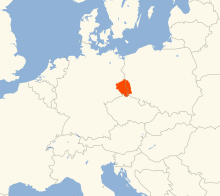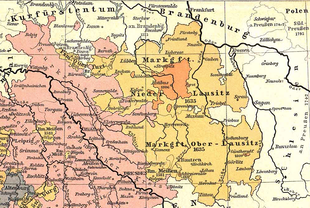Policy of oppression against Sorbs in Prussia and under National Socialism
In the course of its history, the Sorbian ethnic group has repeatedly been the target of oppression .
17./18. century
At the beginning of the 16th century, social changes began in Europe. Through discoveries and economic upswing as well as technical and scientific developments in mining , in the textile and metal industry and scientific worldviews through humanism and the Renaissance , the 16th century became an epoch of the bourgeoisie, the Reformation and the peasant wars. In East Elbe the rising feudal estate economy increased, which was connected with peasant laying , compulsory servants and subservience as well as marriage controls. This made life for the farmers significantly worse. The traditional right of the peasants was abolished. There was strong resistance from the peasants. In Niederlausitz there were also specific features. The borders were changed several times and from the Middle Ages the population experienced massive restrictions and losses, which affected the geographical and political-administrative situation. Due to the loss of areas, Niederlausitz decreased considerably and was heavily divided up due to the economic development from the middle of the 15th century.
The majority of the population in Lausitz were Sorbs. Their share was around 75 percent in Niederlausitz and even higher in the core areas. Around 85 percent of the Sorbs lived in the country and belonged to the rural subjects, although their situation did not differ from the German population in the country. Only 15 percent lived in cities. The Sorbs were able to acquire citizenship , which included property ownership and brewing rights. In 1544 there were 41 percent Sorbs among the citizens of Cottbus who had the right to brew. About 30 percent of the city's residents were Sorbs. In Luckau it was about 50 percent. Most of the Sorbs worked as craftsmen and farmers. There was no way for the Sorbian rural population to get a comprehensive education. In the first half of the 16th century, the barriers fell more and more for the Sorbs, who were not allowed to join the guilds from the 14th century. There were German paragraphs, for example for the shoemakers in Beeskow and the drapers in Cottbus . The guilds allied to be armed against competitors. In smaller cities, where the Sorbs were more strongly represented, the Sorbs were not excluded from the guilds. The rulers often decided in favor of the Sorbs, even if the urban German upper class was not satisfied with it. In Cottbus, the Deutschtum paragraph was abolished in 1525 by the Brandenburg Elector. In the places where the nobility prevailed, there was increased social oppression of the rural population. Nevertheless, the Sorbs should not be displaced and there were no medieval language bans in Niederlausitz. In the Reformation, during which the estates asserted themselves against the will of the Catholic sovereign, this situation was emphasized even more. There was even an increased use of the Sorbian language in the churches, with the estates supporting the training of young Sorbs in the church sector. Sorbian religious literature increasingly appeared and Sorbian cultural life grew stronger.
The situation changed in the last third of the 17th century through absolutism and its centralization and the incorporation of the Sorbs into the centralized state. Particularly in the Duchy of Saxony-Merseburg there was a targeted Germanization, since the margraves exercised rule in Lower Lusatia from 1657 (with the exception of the Brandenburg exclave of the rule Cottbus ). They restricted the power of the estates. In 1667 the Lübben Consistory was founded, which represented state-sponsored Germanization. In 1668 the consistory ordered the complete abolition of the Sorbian language, and this plan was pursued with harshness until the 18th century. The margraves and the consistory had the Sorbian books and manuscripts confiscated and spread the German language among the Sorbian youth through school lessons and church services in German. The Germanization was justified by the fact that the Sorbs hated the Christian rulers and fought against them in many peasant unrest. In 1728 it was decided by the consistory that all preachers should not admit children to Communion who did not have a sufficient command of the German language. In 1729 the sovereign, Duke Moritz Wilhelm von Merseburg , ordered the Sorbian parents to be informed that they should send their children to school in order to learn the German language and the religious way of life. It was similar in Brandenburg and the Kurmark . There the elector ordered the destruction of all Sorbian writings and the abolition of Sorbian church services in the December rescript of 1667. So the Sorbian people lost their meaning and the Sorbian language was gradually lost there. At the same time, a tolerant language policy was pursued in Cottbus and the rural schools in the Cottbus district and religious writings were promoted. New schools sprang up in the villages where Sorbian teachers were hired. Thus the Sorbs in the 17th and 18th centuries were dependent on the respective attitudes of the rulers and their attitudes towards minorities and dissenters in the population.
Anti-Sorbian politics at the time of National Socialism
First of all, the National Socialists tried to include the Sorbs in the new structures and to use them for the National Socialist goals. For example, they wanted to incorporate the Domowina into the Bund Deutscher Osten . The National Socialists' policy later changed when it became apparent that the Sorbian organizations headed by Chairman Pawoł Nedo were resisting it.
In 1937 the National Socialists banned the activities of most of the Sorbian organizations and severely restricted the use of the Sorbian language in public. So they transferred Sorbian teachers and clergy from Lusatia to remote areas of Germany. In this way, the National Socialist regime tried to force the Sorbs to assimilate. Sorbian academics were arrested and some active Sorbs were brought to concentration camps, some of whom, like Maria Grollmuß and Alois Andritzki , no longer lived to see their liberation. At the same time, the National Socialists changed the image of Lusatia for their propaganda and showed an agrarian-romantic image of the Lausitz farmers and an industrial-modern image through the connection with the lignite mining .
The Sorbs were viewed as a Germanic tribe and therefore not systematically exterminated. The Sorbs should be integrated into Germanness. This included the denial of Sorbian identity, language and culture, which was associated with prohibitions, regressions and discrimination. Sorbian events and gatherings were punished by the National Socialists as a violation of public order and security.
In Sorbian language lessons, three hours per week were planned from 1919 onwards, which the National Socialists had postponed to unfavorable times, such as in the late afternoon. In some schools, language teaching has been completely abolished by the regional school and administrative authorities. Some schools, at which the Sorbs made up over half of the students, were declared German educational institutions and, as in Obergurig and Milkel , Sorbian lessons were completely abolished. In the summer of 1933, the repressive policy against the Sorbs in Saxony was ended, initially due to the imperial minority policy. In the Reichstag speech of May 17, 1933, Adolf Hitler spoke out against the assimilization efforts and recognized the historical reference of the European peoples. The foreign policy situation also had an impact on policy towards the Sorbs.
Numerous renaming of places should conceal the Sorbian history of many Upper and Lower Lusatian places. Around 40 Spreewald rivers were also renamed in the Reichskadasterwerk in 1937, whereby the National Socialists canceled this action again in the first years of the war , as there should be no contradicting entries on the maps. Some of the renaming have persisted to this day.
literature
- Max Domarus : Hitler. Speeches and proclamations. Vol. 1: 1932-1938, Würzburg 1962.
- Egbert Jahn : Integration or Assimilation of Ethnic Minorities. On the future of Danish, Sorbian, Italian, Turkish, German and other German countries in the Federal Republic of Germany. Frankfurt am Main 2014.
- Peter Kunze : On the Brandenburg-Prussian Sorbs (Wende) policy in the 17th and 18th centuries. In: Lětopis 46 (1999), pp. 3-15.
- Peter Kunze: Brief history of the Sorbs. Bautzen 2017.
- Edmund Pech: The Effects of National Socialism on the Sorbs National Minority. Pp. 305-322.
- Wolfgang Wippermann : Were the Sorbs persecuted for “racial” reasons during the Nazi era? In: Lětopis 43 (1996), pp. 32-38.
Individual evidence
- ↑ a b c Peter Kunze (1999): On the Brandenburg-Prussian Sorbs (Wende) policy in the 17th and 18th centuries , in: Journal for Sorbian Language, History and Culture, 46 (1999), pp. 3-15 .
- ^ A b c d e Edmund Pech: The Effects of National Socialism on the Sorbs National Minority , pp. 305–322.
- ^ Max Domarus (1962): Hitler. Speeches and proclamations . Volume 1: 1932-1938, Würzburg, p. 273.

